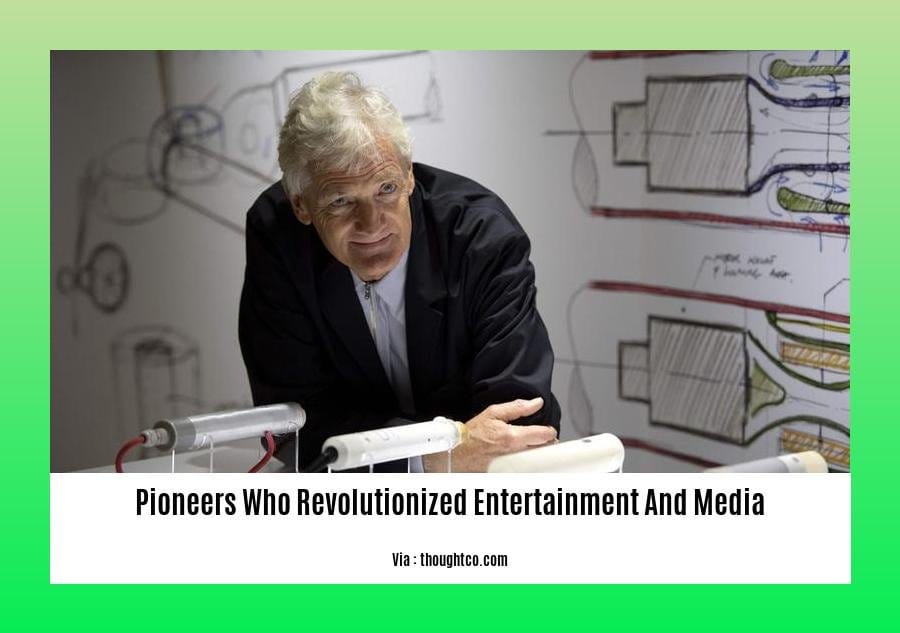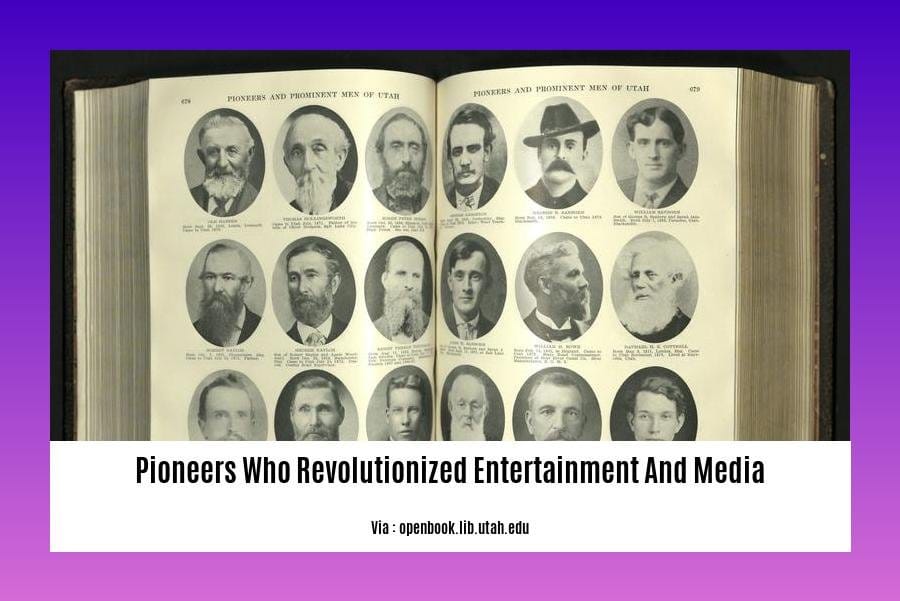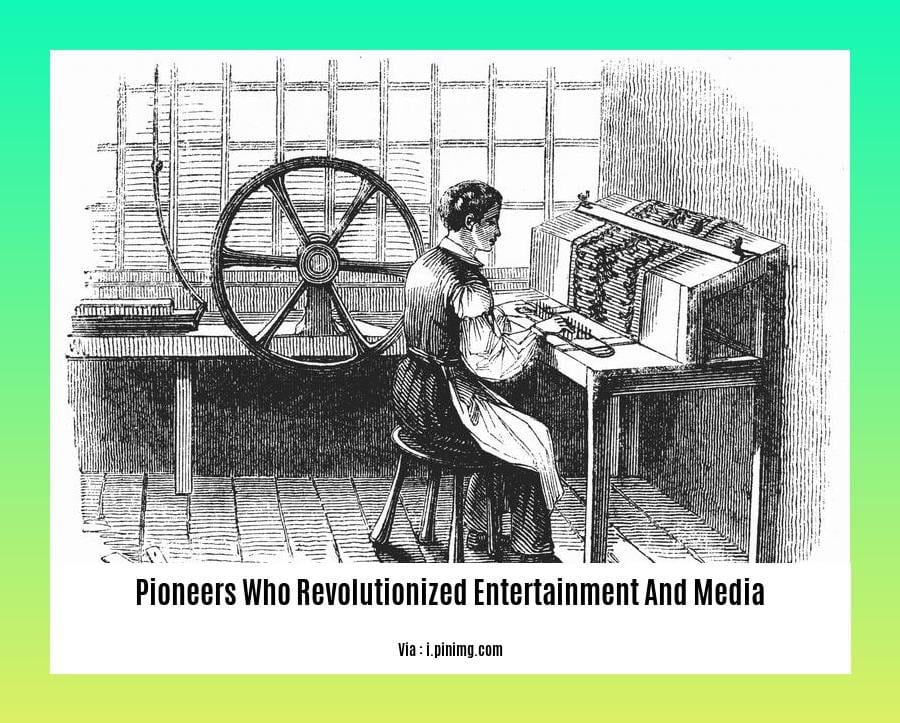In the vibrant tapestry of entertainment and media, there exist luminaries whose visionary brilliance has transformed our experience of these realms. From the silver screen triumphs of the 1920s to the digital streaming revolution of the 21st century, these pioneers have left an indelible mark on our cultural landscape. Join us as we explore the captivating histories of these individuals in “Pioneers Who Revolutionized Entertainment and Media: A Legacy of Innovation and Transformation.”
Key Takeaways:

- Multimedia’s history encompasses early animation to modern installations and performances.
- Industrial Revolution fostered growth in entertainment and media due to increased leisure time and disposable income.
- Technological advancements empowered multimedia installations and performances through sound, video, and time-related elements.
- Don Hewitt pioneered television news production in the 1950s.
- Early video artists connected with experimental film, conceptual art, and performance art.
- Mass media gained prominence in the 20th century with the rise of film and radio.
Pioneers Who Revolutionized Entertainment and Media
Unveiling the trailblazing visionaries who revolutionized entertainment and media is like stepping into a captivating time capsule. Their audacity and ingenuity propelled these realms into uncharted territories, leaving an indelible mark on our cultural landscape.
From the flickering inception of cinema to the immersive digital era, they defied norms and embraced innovation. Their names echo through history as pioneers who reshaped the way we experience, create, and consume entertainment.
In the early days, pioneers like Émile Cohl and Winsor McCay brought animation to life, transforming drawings into captivating motion pictures. Their groundbreaking work paved the way for the animated masterpieces we cherish today.
Moving forward, Don Hewitt emerged as a visionary in the nascent field of television news. His pioneering concept of “60 Minutes” remains a testament to his commitment to in-depth journalism and storytelling.
As the 20th century unfolded, Andy Warhol and other pop artists challenged traditional art forms by incorporating mass media and popular culture into their creations. Their bold experiments blurred the lines between art and entertainment, forever altering our perception of both.
The advent of the digital age unleashed a new generation of pioneers. Steve Jobs and Bill Gates revolutionized computing and paved the way for the internet, transforming entertainment distribution and consumption.
Today, pioneers like Elon Musk and Mark Zuckerberg continue to push the boundaries of media, connecting billions globally through social media platforms and immersive virtual experiences.
These pioneers who revolutionized entertainment and media are not merely individuals; they are architects of our cultural evolution. Their dreams, determination, and relentless pursuit of innovation have enriched our lives, forever changing the way we connect with stories, information, and creativity. Their legacy stands as a beacon of inspiration, reminding us that the power of transformation lies in the audacity to dream and the courage to create.
Learn about the innovative minds who disrupted arts and communication, the trailblazers who transformed content and delivery, and the entertainment and media sector’s great disruptors who revolutionized entertainment and media.
Leisure and consumption in the 1920s
The Roaring Twenties, a decade marked by economic prosperity and cultural change, witnessed a profound transformation in the realm of leisure and consumption. Technological advancements and increased disposable income fueled a surge in entertainment options, reshaping the way people spent their free time.
Radio:
The proliferation of radio broadcasting after World War I brought music, news, and entertainment into countless American homes. With the emergence of commercial radio, advertising became an integral part of the medium, shaping consumer habits and popular culture.
Cinema:
Silent movies dominated the early 1920s, capturing the imagination of audiences. The rise of movie stars and the star system created a new form of celebrity. The introduction of sound in 1927 propelled cinema to new heights, transforming it into a more immersive and engaging experience.
Transformations of leisure Activities:
The increased financial prosperity of the 1920s resulted in more disposable income for entertainment. This, coupled with technological advances, led to a diversification of leisure activities. People flocked to movie theaters, listened to the radio, and pursued hobbies such as dancing, sports, and reading.
Key Takeaways:
- Radio emerged as a pervasive force in American households, broadcasting entertainment and advertising.
- Silent movies captivated audiences, giving rise to movie stars and the star system.
- Sound revolutionized the film industry, creating a more immersive and engaging experience.
- Increased disposable income and technological advancements diversified leisure activities, leading to a surge in entertainment options.
Most Relevant URL:
- Encyclopedia Britannica: 1920s: Film and Theater

FAQ
Q1: How did radio broadcasting contribute to the entertainment landscape in the 1920s?
A1: The widespread adoption of radios in American households during the 1920s led to the emergence of hundreds of radio stations and the integration of advertising into broadcasts. This new medium provided a platform for entertainment and news, shaping public opinion and culture.
Q2: What factors contributed to the rise of cinema as a dominant entertainment form in the 1920s?
A2: The 1920s witnessed the dominance of silent movies, followed by the introduction of sound in 1927. Factors contributing to cinema’s popularity included increased disposable income, technological advancements, and the emergence of movie stars and the star system.
Q3: How did increased leisure time and disposable income impact entertainment consumption patterns in the 1920s?
A3: The Industrial Revolution led to increased financial prosperity and leisure time for many Americans during the 1920s. This resulted in a growing demand for entertainment options, fueling the growth of industries such as cinema, radio, and music.
Q4: What are some examples of technological advancements that shaped the entertainment and media landscape in the 1920s?
A4: Technological advancements in sound, video, and time manipulation played a significant role in the evolution of entertainment and media during the 1920s. These advancements facilitated the development of multimedia installations and performances, pushing the boundaries of artistic expression.
Q5: How did the rise of mass media in the 20th century influence the availability and accessibility of entertainment?
A5: The 20th century saw the rise of mass media through the proliferation of film and radio. These media outlets reached a wide audience, breaking down geographical and cultural barriers. As a result, entertainment became more accessible and available to individuals from diverse backgrounds.
- Crypto Quotes’ Red Flags: Avoid Costly Mistakes - June 30, 2025
- Unlock Inspirational Crypto Quotes: Future Predictions - June 30, 2025
- Famous Bitcoin Quotes: A Deep Dive into Crypto’s History - June 30, 2025
















